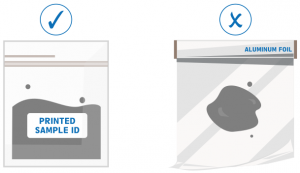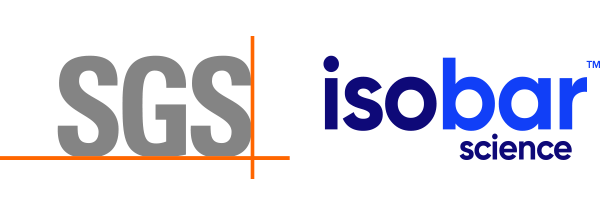Boron Isotope Analysis – Sample Types and Selection
The following recommendations are general guidelines. Individual sample size requirements largely vary based on the material and concentration of boron. Contact us for advice if you are concerned that your samples are too small.
Reminders:
DO NOT wrap samples in aluminum or any metal foil. Use weighing paper if you need to wrap them.
Use plastic vials. DO NOT send samples in a glass vial as it may contaminate your sample with excessive boron.
Submit samples in a ziplock bag or teflon container with PRINTED SAMPLE ID attached outside the bag.

Always choose the best samples for your research objectives
Our recommended sample sizes assume the material is dry and free of adhering matrix.
Black Shale
200 mg
RECOMMENDED CONTAINERPlastic vials
Must be received dry and homogenized or extra charge will be applied.
ALSO AVAILABLE:Cave carbonates
(cave popcorn, carbonate crusts, stalagmites)
200 mg
RECOMMENDED CONTAINERPlastic vials
For the best results, make sure your samples are clean and free from clay particles and other detritus. Must be received dry and homogenized or extra charge will be applied.
ALSO AVAILABLE:Conodont fossils
10 mg
RECOMMENDED CONTAINERPlastic vials
Must be clean and free of detrital. Do not leach samples with acid.
ALSO AVAILABLE:Cold spring carbonates
300 mg
RECOMMENDED CONTAINERPlastic vials
For the best results, make sure your samples are clean and free from clay particles and other detritus. Must be received dry and homogenized or extra charge will be applied.
ALSO AVAILABLE:Flowstones
300 mg
RECOMMENDED CONTAINERPlastic vials
For the best results, make sure your samples are clean and free from clay particles and other detritus. Must be received dry and homogenized or extra charge will be applied.
ALSO AVAILABLE:Gypsum
150 mg
RECOMMENDED CONTAINERPlastic vials
Gypsum microcrystals and gypsiferous (gypsum-rich) sediments: Gypsiferous sediments and gypsum microcrystals contain large quantities of detritic materials. Isolation of gypsum crystals from the matrix fragments must be conducted prior to sample submission. If this is not feasible by the client, Isobar Science offers isolation of gypsum crystals by means of density separation for an additional charge.
For the best results, make sure your samples are clean and free from clay particles and other detritus. Must be received dry and homogenized or extra charge will be applied.
ALSO AVAILABLE:Ikaite minerals
300 mg
RECOMMENDED CONTAINERPlastic vials
For the best results, make sure your samples are clean and free from clay particles and other detritus. Must be received dry and homogenized or extra charge will be applied.
ALSO AVAILABLE:Limestone
300 mg
RECOMMENDED CONTAINERPlastic vials
For the best results, make sure your samples are clean and free from clay particles and other detritus. Must be received dry and homogenized or extra charge will be applied, please contact the lab.
ALSO AVAILABLE:Marine & Lacustrine
Sediments
300 mg
RECOMMENDED CONTAINERPlastic or glass vials
Put them inside a labeled Ziplock bag
Analysis can only be conducted on the leachable fraction. Samples should be homogenized prior to submission.
ALSO AVAILABLE:Sediments
300 mg
RECOMMENDED CONTAINERPlastic vials
Analysis can only be conducted on the leachable fraction. Must be received dry and homogenized or extra charge will be applied.
ALSO AVAILABLE:Shells, Corals &
Bulk Carbonates
200 mg
RECOMMENDED CONTAINERZiplock bags
For the best results, make sure your samples are clean and free from clay particles and other detritus. Do not leach samples with acid. Frequent sonication and rinsing with methanol may be utilized to remove clay particles and other detritus. Homogenize your samples, preferably using an agate mortar and pestle, and transfer into plastic vials. Avoid using any types of glass vials. Homogenized samples will be dissolved in 0.45mol/L HNO3 and the pH of the solution will be adjusted to 7–8.
ALSO AVAILABLE:Soil
500 mg
RECOMMENDED CONTAINERPlastic or glass vials
Put them inside a labeled Ziplock bag
Analysis can only be conducted on the leachable fraction. Samples need to be received in dry and homogenized form. Extra charge will be applied for drying and homogenizing samples, please contact the lab.
ALSO AVAILABLE:Stromatolites
300 mg
RECOMMENDED CONTAINERPlastic vials
Analysis can only be conducted on the leachable fraction. Must be received dry and homogenized or extra charge will be applied.
ALSO AVAILABLE:Tooth & tooth enamel
300 mg
RECOMMENDED CONTAINERPlastic vials
For the best results, make sure your samples are clean and free from clay particles and other detritus. Must be received dry and homogenized or extra charge will be applied.
ALSO AVAILABLE:Travertine
300 mg
RECOMMENDED CONTAINERPlastic vials
For the best results, make sure your samples are clean and free from clay particles and other detritus. Must be received dry and homogenized or extra charge will be applied.
ALSO AVAILABLE:Water
100 mL
RECOMMENDED CONTAINERSmall-neck plastic bottle (HDPE, LDPE, PP)
DO NOT use glass vials.
For boron analysis in water, use any type of small-neck plastic bottle (HDPE, LDPE, PP) to collect your sample. Rinse the bottle with the running sample water prior to collection. Do not add any chemicals to the water, do not acidify the water. Fill the bottle all the way to the top, you may leave a small space at the top (keep the neck of the bottle empty) to allow for any necessary expansion during shipment. Please put the bottles inside a plastic bag and seal the bag with a zip-tie or duct tape. Clearly label both bottle and the plastic bag. Note: Water samples will be screened for boron concentration prior to isotope dilution and extraction chromatography processes for purification and measurement. Only samples with a concentration of 10 ppb or greater will be selected for analysis. If a sample is considered not suitable for analysis, the client will only be charged for the screening.
ALSO AVAILABLE:Isobar Science also offers boron concentration measurements for an additional fee ONLY in conjunction with isotope measurements. Please consult the lab before submitting samples.
Page last updated: January 2020
